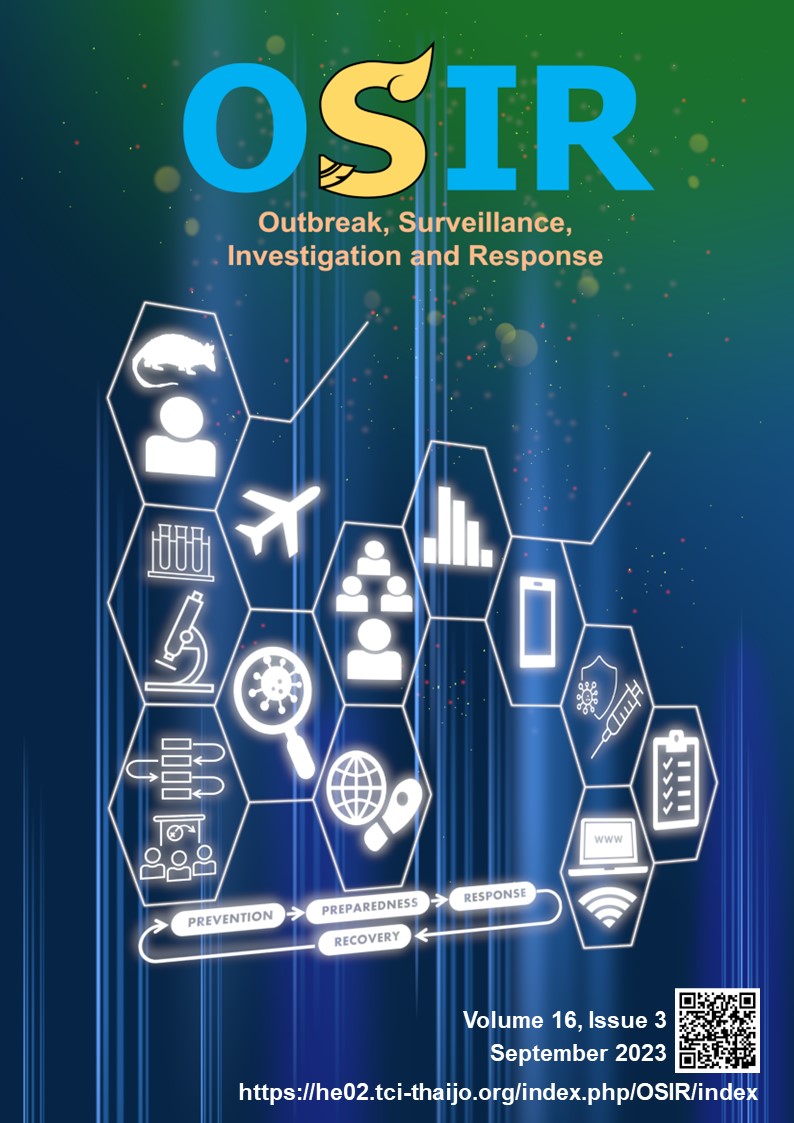Factors Associated with Anthrax Vaccination Coverage in Two Anthrax-prone Districts, Bangladesh, 2019
DOI:
https://doi.org/10.59096/osir.v16i3.265576Keywords:
Anthrax, knowledge, practice, vaccination, BangladeshAbstract
Anthrax is a significant public health threat in Bangladesh due to recent outbreaks in humans and animals. To reduce the incidence of anthrax, the Department of Livestock Services implemented the Preventing Anthrax and Rabies Project (PARB) to enhance anthrax surveillance and response in two anthrax-prone districts. We conducted a retrospective review of PARB data on livestock farmers’ knowledge and practice towards anthrax, anthrax vaccination and anthrax vaccination coverage in six subdistricts of northern and one subdistrict in southwestern Bangladesh. We calculated prevalence ratios (PR) and 95% confidence intervals (CI) to identify risk factors for low vaccination coverage. We found that farmers from farms with low vaccine coverage (<80%) had poor knowledge on animal anthrax (PR 1.75, 95% CI 1.50–1.93) and human anthrax (PR 1.66, 95% CI 1.45–1.87), were less likely to treat (PR 1.79, 95% CI 1.58–1.99) and more likely to slaughter (PR 1.53, 95% CI 1.10–2.09) sick animals than farms with high vaccine coverage. These findings reveal poor knowledge and practices related to anthrax among farmers in low vaccine coverage subdistricts of Bangladesh. Developing and disseminating behavioral change components to farmers can improve their knowledge and practices about anthrax and increase vaccine coverage.
References
Carlson CJ, Kracalik IT, Ross N, Alexander KA, Hugh-Jones ME, Fegan M, et al. The global distribution of Bacillus anthracis and associated anthrax risk to humans, livestock and wildlife. Nat Microbiol. 2019;4(8):1337–43. doi:10.1038/s41564-019-0435-4.
Division of Infectious Disease Epidemiology. Anthrax: surveillance and investigation protocol [Internet]. Charleston: West Virginia Office of Epidemiology and Prevention Services; 2020 Jul [cited 2020 Oct 20]. 14 p. <https://oeps.wv.gov/anthrax/documents/lhd/Anthrax_protocol.pdf>
Institute of Epidemiology, Disease Control and Research. List of outbreak investigation done by IEDCR in 2016–2018 [Internet]. Dhaka: Institute of Epidemiology, Disease Control and Research: c2018 [cited 2021 Sep 16]. <https://old.iedcr.gov.bd/index.php/outbreak>
Sarker MSA, El Zowalaty ME, Ahosanul Haque Shahid M, Sarker MA, Rahman MB, Jarhult JD, et al. Maximization of livestock anthrax vaccination coverage in Bangladesh: An alternative approach. Vaccines. 2020 Aug 4;8(3):435. doi:10.3390/vaccines8030435.
Livestock Research Institute, Vaccine production. Annual reports: tested sample report of October 2020 [Internet]. Dhaka: Livestock Research Institute; 2020 Nov 25 [cited 2020 Dec 5]. <http://lri.gov.bd/site/annual_reports/fac9f38b-d3b3-422f-9a64-52adcd9e56d5/->. Bengali.
Rume FI. Epidemiology of anthrax in domestic animals of Bangladesh [dissertation]. Dhaka: Faculty of Biological Sciences, University of Dhaka; 2016. 38 p.
Rume FI, Karim MR, Ahsan CR, Yasmin M, Biswas PK. Risk factors for bovine anthrax in Bangladesh, 2010-2014: A case-control study. Epidemiol Infect. 2020 Feb 28;148:e67. doi:10.1017/S0950268820000576.
Bangladesh Bureau of Statistics. Preliminary report on agriculture census 2019 [Internet]. Dhaka. Bangladesh Bureau of Statistics; 2019 Oct. 68 p. <https://bbs.portal.gov.bd/sites/default/files/files/bbs.portal.gov.bd/page/b343a8b4_956b_45ca_872f_4cf9b2f1a6e0/9beb0d821f582859681d77f76e89e321.pdf>
Pantha B, Day J, Lenhart S. Optimal control applied in an anthrax epizootic model. Journal of Biological Systems. 2016;24(4):495–517. doi:10.1142/S021833901650025X.
Dutta PK, Biswas H, Ahmed JU, Shakif-Ul-Azam M, Ahammed BMJ, Dey AR. Knowledge, attitude and practices (KAP) towards Anthrax among livestock farmers in selected rural areas of Bangladesh. Vet Med Sci. 2021 Sep;7(5):1648–55. doi: 10.1002/vms3.561.
Traxler RM, Napetvaridze T, Asanishvili Z, Geleishvili M, Rukhadze K, Maghlakelidze G, et al. Knowledge, attitudes, and practices related to anthrax and animal care: A case-control study in Georgia. PLoS One. 2019 Oct 18;14(10):e0224176. doi:10.1371/journal.pone.0224176.
Inglesby TV, O’Toole T, Henderson DA, Bartlett JG, Ascher MS, Eitzen E, et al. Anthrax as a Biological Weapon, 2002 Updated Recommendations for Management. JAMA. 2002; 287(17):2236–52. doi:10.1001/jama.287.17.2236.
Animal slaughter and meat quality control act 2011 [Internet]. Dhaka: Department of Livestock Services; 2011 [cited 2021 Feb 19]. 11 p. <http://www.dls.gov.bd/site/view/law> Bangali.
Animal disease act 2005 [Internet]. Dhaka: Department of Livestock Services; 2005 [cited 2023 Sep 20]. 14 p. <https://mofl.gov.bd/site/view/law/Fish-and-Livestock-related-all-laws>. Bangali.
Downloads
Published
How to Cite
Issue
Section
License
Copyright (c) 2023 Outbreak, Surveillance, Investigation & Response (OSIR) Journal

This work is licensed under a Creative Commons Attribution-NonCommercial-NoDerivatives 4.0 International License.








